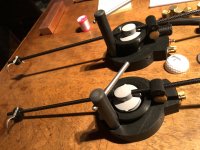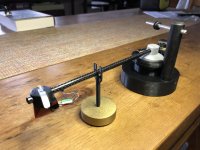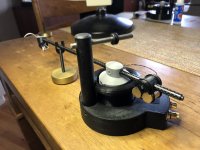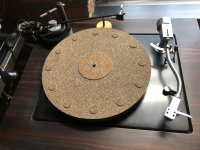I'm making a couple 3D-printed tonearms using carbon fiber tubes (7mm OD x 5mm ID) and hope you have tips on grounding. I've made a few arms in the past (the first used a spare wired WT arm wand) for self[-use and followed what's been done by Well Tempered, but there's often ground hum once done...
I use very fine Litz wires, which are coated with enamel and wrapped with silk. I separately twisted left and right pairs and then wrap them with the ground wire, which connects at the table's ground post and floats free inside the arm after wrapping around the twisted left and right pairs. Well Tempered connected their ground to a screw at the end of the metal tone arm shaft behind the headshell mount, but theres no metal to connect to with a fiber shaft...
For damping, I use hermit crab sand, which seems to work well. I cut apart a large O-ring to close off the arm ends and cut apart smaller rings to fill to holes where the wires feed in and out.
There's very little room in an arm like this in which to add a loosely woven shield netting around the arm wires, etc... Once completed, my arms seem to have a bit of a hum, not noticeable when the music is being played but audible in silent passages.
I see that others have run the arm pairs outside along the sides of the fiber arm tube, holding them in place with heat shrink tubing...
btw: We all know how hard it is to solder Litz wires - I've had luck removing the enamel on the Litz wires by fanning out the tiny wires and dabbing them with lacquer thinner first.
Thoughts?
I use very fine Litz wires, which are coated with enamel and wrapped with silk. I separately twisted left and right pairs and then wrap them with the ground wire, which connects at the table's ground post and floats free inside the arm after wrapping around the twisted left and right pairs. Well Tempered connected their ground to a screw at the end of the metal tone arm shaft behind the headshell mount, but theres no metal to connect to with a fiber shaft...
For damping, I use hermit crab sand, which seems to work well. I cut apart a large O-ring to close off the arm ends and cut apart smaller rings to fill to holes where the wires feed in and out.
There's very little room in an arm like this in which to add a loosely woven shield netting around the arm wires, etc... Once completed, my arms seem to have a bit of a hum, not noticeable when the music is being played but audible in silent passages.
I see that others have run the arm pairs outside along the sides of the fiber arm tube, holding them in place with heat shrink tubing...
btw: We all know how hard it is to solder Litz wires - I've had luck removing the enamel on the Litz wires by fanning out the tiny wires and dabbing them with lacquer thinner first.
Thoughts?
Last edited:
For MC I am suprised you get hum, they are usually fairly resilient.
MM the cart itself is grounded by one of the negative wires.
Wires are twisted together which is the best you can do given getting coax down there is hard. I'd be tempted to tripple check the run to your preamp and the grounding of that.
Any pictures to share of the whole setup?
MM the cart itself is grounded by one of the negative wires.
Wires are twisted together which is the best you can do given getting coax down there is hard. I'd be tempted to tripple check the run to your preamp and the grounding of that.
Any pictures to share of the whole setup?
reply to post
You are the first to see 'em. Making a 9" and a 10.5" for use on my Braun PCS5 and a Neat Shield MO-19 idler. The base adjusts to accommodate the taller Neat platter.
I made two arms for them previously, using existing parts, brass disks, pipe end caps, stainless steel... it was hard to get done because I had to depend so much on others for drilling. Now that I have a FlashForge Finder printer, it's all in house! Bases will be filled with steel balls or cut brass rod for weight. I'l be able to move them to other tables easily with the wiring done in the bases.
You are the first to see 'em. Making a 9" and a 10.5" for use on my Braun PCS5 and a Neat Shield MO-19 idler. The base adjusts to accommodate the taller Neat platter.
I made two arms for them previously, using existing parts, brass disks, pipe end caps, stainless steel... it was hard to get done because I had to depend so much on others for drilling. Now that I have a FlashForge Finder printer, it's all in house! Bases will be filled with steel balls or cut brass rod for weight. I'l be able to move them to other tables easily with the wiring done in the bases.
Attachments
I had the same problem when I redid the tonearm wire with Litz wire. I ended up with grounding the aluminium arm, and put a copper grounding sleeve around the signal cables going to the phono amp. I terminated only one sleeve end to phono gnd. Perhaps you could wrap copper foil around the Litz wire inside the arm and solder a Litz wire to it and then connect the wire to phono amp gnd. Dont know how easy foil will be to solder though.. https://www.ebay.com/sch/i.html?_fr...=0&LH_TitleDesc=0&_osacat=0&_odkw=copper+film
I've been looking for a metal netting of sorts... I like the idea of a copper grounding sleeve...
What about a copper plated straw? .5cm OD... I have a little more than 5mm ID. Wonder if I could line the carbon rod with one of these and drill thru t it and screw the ground wire to it near the pivot?
Premium Copper Straws | ALANDIA Online Store
Hmmm...
What about a copper plated straw? .5cm OD... I have a little more than 5mm ID. Wonder if I could line the carbon rod with one of these and drill thru t it and screw the ground wire to it near the pivot?
Premium Copper Straws | ALANDIA Online Store
Hmmm...
Last edited:
I purchased this for shielding litz in my tonearm projects.
Amazon.com: 1/8" Tinned Copper Metal Braided Sleeving (0.08" Diameter) - 10FT: Home Improvement
It looks like it would fit inside your CF tubing.
It is quite small in its contracted state, more like 1/16” externally.
It expands beyond 1/8” while feeding wires through in a push/pull manner an inch or so at a time carefully.
I usually snake through a piece of solid core wire first and then tape my litz to the end and pull it through carefully
Amazon.com: 1/8" Tinned Copper Metal Braided Sleeving (0.08" Diameter) - 10FT: Home Improvement
It looks like it would fit inside your CF tubing.
It is quite small in its contracted state, more like 1/16” externally.
It expands beyond 1/8” while feeding wires through in a push/pull manner an inch or so at a time carefully.
I usually snake through a piece of solid core wire first and then tape my litz to the end and pull it through carefully
The only commercial CF tonearm i have owned was suffering the same issue. Utterly unusable with a MM cart and generally hum-free with MCs, unless a power transformer was in the vicinity. The manufacturer, rather condescendingly advised that at this price range no one would use an MM cart.
My ccarbon fiber tubes are not conductive. I hadn't thought of coating the inside wth conductive copper paint... I may go for the 1/4" Tinned Copper Metal Braided Sheeving which, according to the description, comes out as .16 d. which may give me room for a small piece of silk.
Pretty to post
Yes, I've thought about that. I see the install going something like this:
Feed the ground wire thru the pivot hole and out the back (may need a monofilament lead to pull it with), where I'll solder it to the sleeve, which has two oval holes cut out of it for entry of the wires in at the pivot and out behind the headshell. Run monofilament thru the front to the pivot hole and another thru the front and out of the front exit hole. Then I'll tie these monofilaments together and to the arm wires. I'll pull the sleeving thru from the back to the front and wrap it over the front end and twist tie it in place - after the wires are installed, I'll pull it forward and cut it off.
Arm wires will be twisted pairs red/green and white/blue, a twist about every 1/4 inch. These will be wrapped more loosely around a thin piece of silk and, hopefully will enter the sleeving from the pivot hole and pull thru the front side hole. If successful, I'll check continuity, add a piece of a 5mm diameter O-ring stopper to the front and smaller pieces to close off the two small entry exit holes, then fill the arm with hermit crab sand. The sand is extremely fine and has damped other arms very well. I'll add another O-ring stopper to the end.
Sound right?
Drill a small hole and insert a screw.
Yes, I've thought about that. I see the install going something like this:
Feed the ground wire thru the pivot hole and out the back (may need a monofilament lead to pull it with), where I'll solder it to the sleeve, which has two oval holes cut out of it for entry of the wires in at the pivot and out behind the headshell. Run monofilament thru the front to the pivot hole and another thru the front and out of the front exit hole. Then I'll tie these monofilaments together and to the arm wires. I'll pull the sleeving thru from the back to the front and wrap it over the front end and twist tie it in place - after the wires are installed, I'll pull it forward and cut it off.
Arm wires will be twisted pairs red/green and white/blue, a twist about every 1/4 inch. These will be wrapped more loosely around a thin piece of silk and, hopefully will enter the sleeving from the pivot hole and pull thru the front side hole. If successful, I'll check continuity, add a piece of a 5mm diameter O-ring stopper to the front and smaller pieces to close off the two small entry exit holes, then fill the arm with hermit crab sand. The sand is extremely fine and has damped other arms very well. I'll add another O-ring stopper to the end.
Sound right?
Hm. Just a thought. Treat the cart like a balanced source. Remove the ground strap from the leg of the cart, and run that separate. Feed to a balanced-input pre-amp. Hum gone.

Have you got the hum when the stylus if lifted just off the record surface? Does the hum change when you move the arm across the record surface (but not touching it)? This will help you identify if its coming from the motor or some other source in the vicinity. One of the reasons high-end T/T's often mount the motor away from the platter is for electrical noise reasons and not just mechanical noise.
I had a Project turntable ('Carbon' IIRC) that was OK'ish with the needle off the record surface but terrible when playing the record - the cause was motor noise and I had to buy a special kit (£25) from Henley (Project importers in the UK) to quiet it down. Why not just supply a turntable without this problem you may be asking which is the same question I had.
Anyway, assuming its not motor noise, you would need to determine the coupling mechanism - if it is electro-magnetic i.e. from the motor windings or a nearby transformer - shielding won't really help. For that problem, you need to rely on twisting the wires from the cart to the connectors at the base of the arm. If its capacitive coupling then screening the wires would help.
If you short out the wires at the cartridge end in the head shell do you still get the problem?
One other question, are you keeping your signal ground separate from the T/T ground, assuming it has one?
I had a Project turntable ('Carbon' IIRC) that was OK'ish with the needle off the record surface but terrible when playing the record - the cause was motor noise and I had to buy a special kit (£25) from Henley (Project importers in the UK) to quiet it down. Why not just supply a turntable without this problem you may be asking which is the same question I had.
Anyway, assuming its not motor noise, you would need to determine the coupling mechanism - if it is electro-magnetic i.e. from the motor windings or a nearby transformer - shielding won't really help. For that problem, you need to rely on twisting the wires from the cart to the connectors at the base of the arm. If its capacitive coupling then screening the wires would help.
If you short out the wires at the cartridge end in the head shell do you still get the problem?
One other question, are you keeping your signal ground separate from the T/T ground, assuming it has one?
Last edited:
Finished my two arms - here's the 9" at it's highest adjustable height and installed on the table. I used a tinned copper shielding inside and hermit crab sand to damp the arm tube. It's on my 1962 Braun PCS5 for now. Original headshell of the Braun was upgraded last year. My 3D printed subplatter ring (not shown) reduces the 33-1/3rpm position speed to 33.7rpm by enlarging the subplatter's diameter. This was due to the motor being 50Hz and running fast under 60Hz US power. Using a thread belt also helped reduce speed. Sounds fantastic. Mono cartridge in the original arm.
Attachments
Last edited:
Finished my two arms - here's the 9" at it's highest adjustable height and installed on the table. I used a tinned copper shielding inside and hermit crab sand to damp the arm tube. Mounted it on my 1962 Braun PCS5 for now. Original headshell of the Braun was upgraded last year. My 3D printed subplatter ring reduces the 33-1/3rpm position speed to 33.7rpm by enlarging the subplatter's diameter. Using a thread belt also helped reduce speed. Sounds fantastic. Mono cartridge in the original arm.
- Status
- This old topic is closed. If you want to reopen this topic, contact a moderator using the "Report Post" button.
- Home
- Source & Line
- Analogue Source
- Tips for grounding a carbon fiber tonearm?



